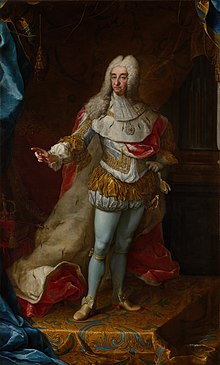
Back فيتوريو أميديو الثاني Arabic فيتوريو اميديو التانى ARZ II Viktor Amadey (Savoyya hersoqu) Azerbaijani ایکینجی ویکتور آمادیو ساردینی AZB Віктар Амадэй II Byelorussian Виктор Амадей II Савойски Bulgarian Vittorio Amedeo II Breton Víctor Amadeu II de Savoia Catalan Viktor Amadeus II. Czech Viktor Amadeus 2. af Sardinien-Piemont Danish
| Victor Amadeus II | |||||
|---|---|---|---|---|---|
 Portrait by Martin van Meytens (1728, Palace of Venaria) | |||||
| King of Sardinia | |||||
| Reign | 17 February 1720 – 3 September 1730 | ||||
| Predecessor | Charles VI, Holy Roman Emperor | ||||
| Successor | Charles Emmanuel III | ||||
| King of Sicily | |||||
| Reign | 22 September 1713 – 17 February 1720 | ||||
| Coronation | 24 December 1713 | ||||
| Predecessor | Philip IV | ||||
| Successor | Charles IV | ||||
| Duke of Savoy | |||||
| Reign | 12 June 1675 – 3 September 1730 | ||||
| Predecessor | Charles Emmanuel II | ||||
| Successor | Charles Emmanuel III | ||||
| Regent | Marie Jeanne (1675-1684) | ||||
| Born | 14 May 1666 Royal Palace, Turin, Savoy | ||||
| Died | 31 October 1732 (aged 66) Castle of Rivoli, Turin, Savoy | ||||
| Burial | Basilica of Superga, Turin, Italy | ||||
| Spouses | |||||
| Issue Detail | |||||
| |||||
| House | Savoy | ||||
| Father | Charles Emmanuel II, Duke of Savoy | ||||
| Mother | Marie Jeanne Baptiste of Nemours | ||||
| Religion | Catholic Church | ||||
| Signature |  | ||||
Victor Amadeus II (Vittorio Amedeo Francesco; 14 May 1666[1] – 31 October 1732) was the head of the House of Savoy and ruler of the Savoyard states from 12 June 1675 until his abdication in 1730. He was the first of his house to acquire a royal crown, ruling first as King of Sicily (1713–1720) and then as King of Sardinia (1720–1730). Among his other titles were Duke of Savoy, Duke of Montferrat, Prince of Piedmont, Marquis of Saluzzo and Count of Aosta,[2] Maurienne and Nice.
Louis XIV arranged his marriage in order to maintain French influence in Savoy, but Victor Amadeus soon broke away from the influence of France. At his father's death in 1675, his mother, Marie Jeanne Baptiste of Nemours, was regent in the name of her nine-year-old son and would remain in de facto power until 1684 when Victor Amadeus banished her further involvement in the state.[3] Having fought in the War of the Spanish Succession, he was rewarded with the Kingdom of Sicily in 1713, but he was forced to exchange this title for the poorer Kingdom of Sardinia in 1720.[4]
Reigning for over 55 years, he is the longest reigning monarch in Savoyard history, surpassing Charles Emmanuel I. Victor Amadeus left a considerable cultural influence in Turin, remodeling the Royal Palace of Turin, Palace of Venaria, Palazzina di caccia of Stupinigi, as well as building the Basilica of Superga where he rests.[5]
- ^ Oresko 2004, p. 23.
- ^ International Society for Nobility and Heraldry (19 November 2021), The Count Of Donnas Dal Val D' Aosta, retrieved 16 June 2023
- ^ Symcox 1983, p. 69.
- ^ Storrs 1999, p. 160.
- ^ Symcox 1983, p. 78.
© MMXXIII Rich X Search. We shall prevail. All rights reserved. Rich X Search